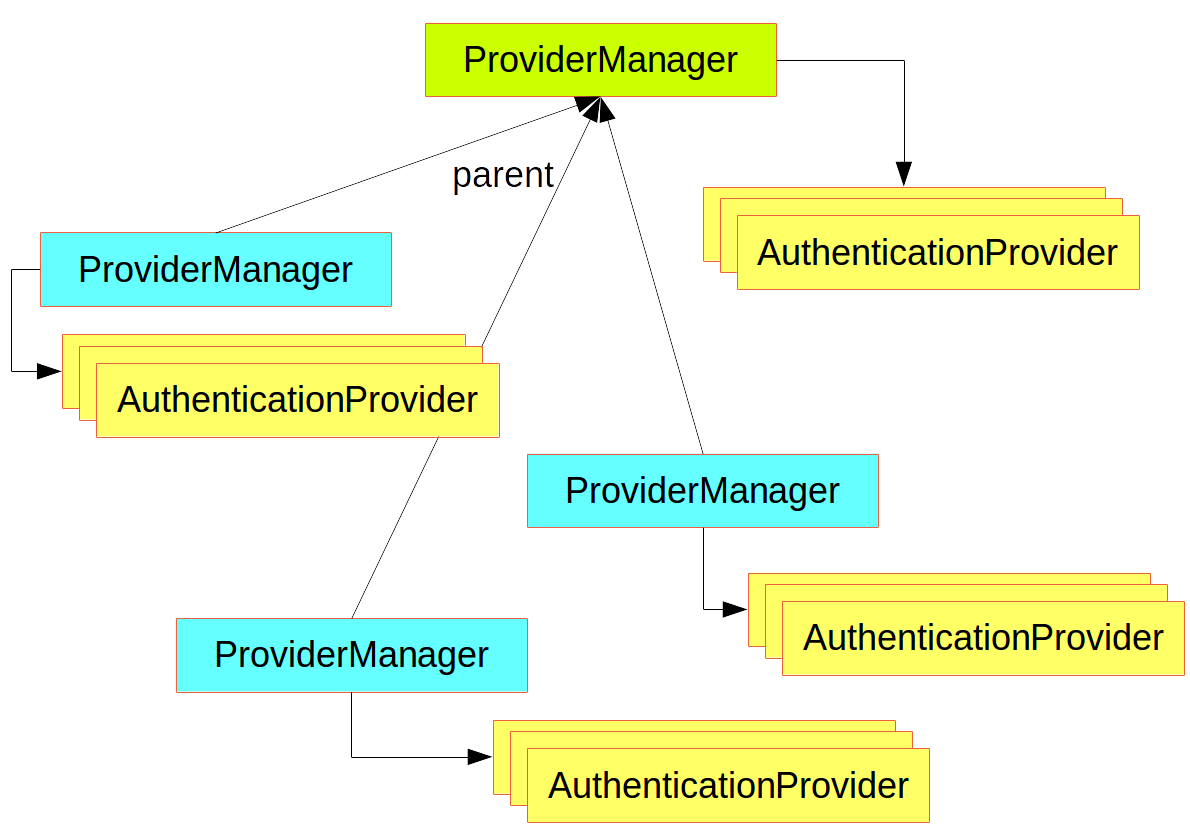스프링의 공식 가이드를 해석한 글입니다.
영어가 많이 부족하기 때문에 내용의 생략과 오류가 있을 수 있습니다.
출처 https://spring.io/guides/topicals/spring-security-architecture
인증(Authentication) 과 인가(Access Control)
애플리케이션 보안은 대략 두개의 독립적인 문제로 요약할 수 있다.
인증 (당신은 누군가?) 과 인가 (어떤 행위를 할 수 있도록 허가받았는가?) 이다.
가끔은 "인가" 대신 "접근 제어" 로 불리기도 한다
스프링 시큐리티는 인증을 인가로부터 분리하도록 디자인된 구조를 갖고 있고
둘의 전략과 extension point(?)를 갖는다.
인증(Authentication)
인증을 위한 주요 인터페이스는 AuthenticationManager 이다.
하나의 메서드만을 갖는다.
public interface AuthenticationManager {
Authentication authenticate(Authentication authentication)
throws AuthenticationException;
}AuthenticationManager는 authenticat() 메서드를 통해
3가지 일을 할 수 있다.
-
입력이 타당하면 Authentication(보통 authenticated=true와 함께)
객체를 반환한다. -
입력이 타당하지 않다고 판단되면 AuthenticationException을 반환한다.
-
판단할 수 없으면 null을 반환한다.
AuthenticationException은 런타임 예외이다.
애플리케이션의 목적과 스타일에 따라 일반적인 방식으로 애플리케이션에게 처리된다.
다르게 말하면, 개발자의 코드는 보통 이것을 catch하거나 처리하지 않는다.
(해석이 모호한 부분)
예를 들어 한 UI가 인증이 실패했다는 페이지를 렌더링하고
WWW-Authenticate 헤더와 상관 없이 context에 따하
백엔드 HTTP 서비스에서는 401을 응답한다.
(해석이 모호한 부분)AuthenticationManager 의 가장 흔하게 사용되는 구현체는 ProviderManager이다.
이것은 여러개의 AuthenticationProvider 객체에게 위임(delegation)한다.
AuthenticationProvider는 AuthenticationManager와 약간 비슷하다.
하지만 호출자가 이것이 주어진 Authintication 타입을 지원하는지
질의할 수 있는 추가적인 메서드를 갖고있다.public interface AuthenticationProvider { Authentication authenticate(Authentication authentication) throws AuthenticationException; boolean supports(Class<?> authentication); }supports() 메서드의 Class<?> 파라미터는
사실 Class<? extends Authentication>이다.
(authenticate() 메서드를 통해 받은 것만에 대해 지원하는지 질의 받는다.)
ProviderManager는 여러개의 AuthenticationProvider들에게 위임하는 것을 통해
다양한 인증 메커니즘을 지원할 수 있다.
ProviderManager가 특정한 Authentication 타입을 인식하지 못하면
스킵된다.
ProviderManager는 모든 ProviderManager가 null을 반환하는지
알 수 있는 선택적인 부모를 갖는다.
부모가 없으면 null인 Authentication은 AuthenticationException을 던진다.
가끔은 애플리케이션이 보호된 자원의 논리적 그룹들을 갖는다.
(예를 들어 같은 경로 패턴을(/api/**와 같은) 갖는 모든 웹 자원)
각각의 그룹은 자신의 전용 AuthenticationManager을 가질 수 있다.
보통은 ProviderManager을 갖고 같은 부모를 공유한다.
부모는 일종의 "global" 자원이고 모든 provider들의 fallback 역할을 한다.
(fallback이란 어떤 기능이 제대로 동작하지 않을때 이에 대처하는 기능이나 동작)

Authentication Managers들을 커스터마이징하기
스프링 시큐리티는 공통의 authentication manager 의 특징의 셋업을
빠르게 할 수 있도록 도와주는 설정 도우미가 있다.
가장 흔히 쓰이는 도우미는 AuthenticationManagerBuilder이다.
in-memory,JDBC, LDAP 유저 디테일이나
커스텀 UserDetailsService을 추가하는데 훌륭하다.
아래의 예제는 gloabl(부모) AuthenticationManager을
설정하는 애플리케이션을 보여준다.
@Configuration
public class ApplicationSecurity extends WebSecurityConfigurerAdapter {
... // web stuff here
@Autowired
public void initialize(AuthenticationManagerBuilder builder, DataSource dataSource) {
builder.jdbcAuthentication().dataSource(dataSource).withUser("dave")
.password("secret").roles("USER");
}
}이 예제는 웹 애플리케이션과 연관돼있다.
하지만 이런 AuthenticationManagerBuilder의 사용은 더 넓게 응용할 수 있다.
(웹 보안이 어떻게 구현되는지는 https://spring.io/guides/topicals/spring-security-architecture#web-security 을 봐라)
AuthenticationManagerBuilder 가 메서드 안에 스프링 빈으로 인식돼
@Autowired(주입)됐는지 확인하자. 이게 glabal(부모) AuthenticationManager을 만든다.
반대로, 아래의 예제를 보자.
@Configuration
public class ApplicationSecurity extends WebSecurityConfigurerAdapter {
@Autowired
DataSource dataSource;
... // web stuff here
@Override
public void configure(AuthenticationManagerBuilder builder) {
builder.jdbcAuthentication().dataSource(dataSource).withUser("dave")
.password("secret").roles("USER");
}
}configurer의 @Override 메서드를 사용하면,
AuthenticationManagerBuilder 는 글로벌 부모의 하나의 자손인 "로컬" AuthenticationManager 을 만들기 위해서만 쓰일 것이다.
스프링 부트 애플리케이션에서 글로벌 매니저를 또다른 빈에 주입할 수 있다.
하지만 스스로 명백하게 노출시키지(?) 않는 한 로컬 매니저는 다른 빈에 주입 할 수 없다.
따로 AuthenticationManager 타입의 빈을 만들지 않는 한,
스프링 부트는 기본 글로벌 AuthenticationManager을 제공한다.
기본으로 제공되는건 걱정 할 필요 없이 충분히 안전하다.
AuthenticationManager을 빌드하는 어떤 설정을 만들려면
보통 기본으로 제공되는 AuthenticationManager에 대해 고려하지 않아도
지역적으로 보호하려는 자원에 할 수 있다.
